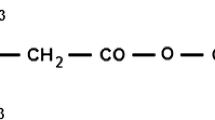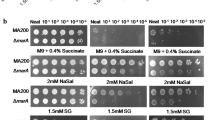Summary
A multi-copy plasmid containing the SNQ3 gene confers hyper-resistance to 4-nitroquinoline-N-oxide (4NQO), Trenimon, MNNG, cycloheximide, and to sulfometuron methyl in yeast transformants. Restriction analysis, subcloning, and DNA sequencing revealed an open reading frame of 1950 bp on the SNQ3-containing insert DNA. Gene disruption and transplacement into chromosomal DNA yielded 4NQO-sensitive null mutants which were also more sensitive than the wild-type to Trenimon, cycloheximide, sulfometuron methyl, and MNNG. Hydropathic analysis showed that the SNQ3-encoded protein is most likely not membrane-bound, while the codon bias index points to low expression of the gene.
Similar content being viewed by others
References
Ausubel FM, Brent R, Kingston RE, Moore DD, Seidman JG, Smith JA, Struhl K (1988) Current protocols in molecular biology, vols 1 and 2. Wiley Interscience, New York
Balzi E, Chen W, Ulaszewski S, Capieaux E, Goffeau A (1987) J Biol Chem 262: 16871–16879
Bennetzen JL, Hall BD (1982) J Biol Chem 257: 3026–3031
Birnboim HG, Doly J (1979) Nucleic Acids Res 7: 1513–1523
Boyer HW, Roulland-Dussoix D (1969) J Mol Biol 41: 459–472
Brendel M, Mack M, Gömpel-Klein P, Haase E (1990) Dechema Biotechnol Conf 3: 287–290
Carlson M, Botstein D (1982) Cell 28: 145–154
Chaleff RS, Mauvais CJ (1984) Science 224: 1443–1444
Chen C, Chin JE, Ueda K, Clark DP, Pastan I, Gottesman MM, Roninson IB (1986) Cell 47:381–389
Dagert M, Ehrlich SD (1979) Gene 6: 23–28
Del Sal G, Manfioletti G, Schneider C (1988) Nucleic Acids Res 16: 9878
Endicott AE, Ling V (1989) Annu Rev Biochem 58: 137–171
Falco SC, Dumas KS (1985) Genetics 109: 21–35
Fleer R, Brendel M (1979) Mol Gen Genet 176: 41–52
Gerlach JH, Endicott JA, Juranka PF, Henderson G, Sarangi F, Deuchars KL, Ling V (1986) Nature 324: 485–489
Gömpel-Klein P, Brendel M (1990) Curr Genet 18: 93–96
Gömpel-Klein P, Mack M, Brendel M (1989) Curr Genet 16: 65–74
Gros P, Croop J, Housman D (1986a) Cell 47: 371–380
Gros P, Neriah YB, Croop JM, Housman DE (1986b) Nature 1323: 728–731
Haase E (1990) Doctoral Thesis, FB Biologie der J. W. Goethe-Universität, Frankfurt am Main, Federal Republic of Germany
Haase F, Riehl D, Mack M, Brendel M (1989) Mol Gen Genet 218: 64–71
Hammond JR, Johnstone RM, Gros P (1989) Cancer Res 49: 3867–3871
Henikoff S (1984) Gene 28: 351–359
Henikoff S (1987) Methods Enzymol 15: 156–165
Huisman O, Raymond W, Froehlich KU, Errada P, Kleckner N, Botstein D, Hoyt MA (1987) Genetics 116: 191–199
Käppeli O (1986) Microbiol Rev 50: 244–258
Ito H, Fukuda J, Murata K, Kimura A (1983) J Bacteriol 153: 163–168
Kanazawa S, Driscoll M, Struhl K (1988) Mol Cell Biol 8: 664–673
Kyte J, Doolittle RF (1982) J Mol Biol 157: 105–132
Leppert G, McDevitt R, Falco SC, VanDyk TK, Ficke MB, Golin J (1990) Genetics 125: 13–20
Mack M, Gömpel-Klein P, Haase E, Hietkamp J, Ruhland A, Brendel M (1988) Mol Gen Genet 211: 260–265
Maniatis T, Fritsch EF, Sambrook J (1982) Molecular cloning: a laboratory manual. Cold Spring Harbor Laboratory, Cold Spring Harbor, New York
McGrath JP, Varshavsky A (1989) Nature 340: 400–404
Meister A, Anderson ME (1983) Annu Rev Biochem 52: 711–760
Miller JH (1972) Experiments in molecular genetics. Cold Spring Harbor Laboratory, Cold Spring Harbor, New York
Nebert DW (1987) Annu Rev Biochem 56: 945–993
Pickett CB (1989) Annu Rev Biochem 58: 743–764
Rank GH (1986) Can J Genet Cytol 28: 852–855
Riordan JR, Deuchars K, Kartner N, Alon N, Trent J, Ling V (1985) Nature 316: 817–819
Rodriguez RL, Tait RC (1983) Recombinant DNA-techniques (an introduction). Addison-Wesley, London
Roninson IB, Abelson HT, Housman DE, Howell N, Varshavsky A (1984) Nature 309:626–628
Rothstein RJ (1983) Methods Enzymol 101: 202–209
Ruhland AR, Brendel M (1979) Genetics 92: 83–97
Ruhland AR, Haase E, Siede W, Brendel M (1981) Mol Gen Genet 181: 346–351
Ruhland AR, Brendel M, Haynes RH (1986) Curr Genet 11: 211–215
Sambrook J, Fritsch EF, Maniatis T (1989) Molecular cloning: a laboratory manual. Cold Spring Harbor Laboratory, Cold Spring Harbor, New York
Sanger F, Nicklen S, Coulson AR (1977) Proc Natl Acad Sci USA 74: 5463–5467
Saunders GW, Rank CH (1982) Can J Genet Cytol 24: 493–503
Siede W (1926) Doctoral Thesis, FB Biologie der J. W. Goethe-Universität, Frankfurt am Main, Federal Republic of Germany
Subik J, Ulaszewski S, Goffeau A (1986) Curr Genet 10: 665–670
Sugimura T, Okabe K, Endo H (1965) Gann 58: 489–501
Tada, M (1981) In: Sugimura T (ed), Carcinogenesis vol. 6. Raven Press, New York, pp 25–45
Tada M, Tada M (1975) Nature 255: 510–512
Tautz D, Renz M (1983) Anal Biochem 132: 114–119
Walker JE, Saraste M, Runswick MJ, Gay NJ (1982) EMBO J 1: 945–951
Way JC, Davis MA, Morisato D, Roberts DE, Kleckner N (1984) Gene 32: 369–379
Wehner E, Seelmann K, Brendel M (1991) Mol Gen Genet (submitted)
Zaret KS, Sherman F (1982) Cell 28: 563–573
Author information
Authors and Affiliations
Additional information
Communicated by K. Wolf
Rights and permissions
About this article
Cite this article
Hertle, K., Haase, E. & Brendel, M. The SNQ3 gene of Saccharomyces cerevisiae confers hyper-resistance to several functionally unrelated chemicals. Curr Genet 19, 429–433 (1991). https://doi.org/10.1007/BF00312733
Received:
Issue Date:
DOI: https://doi.org/10.1007/BF00312733




